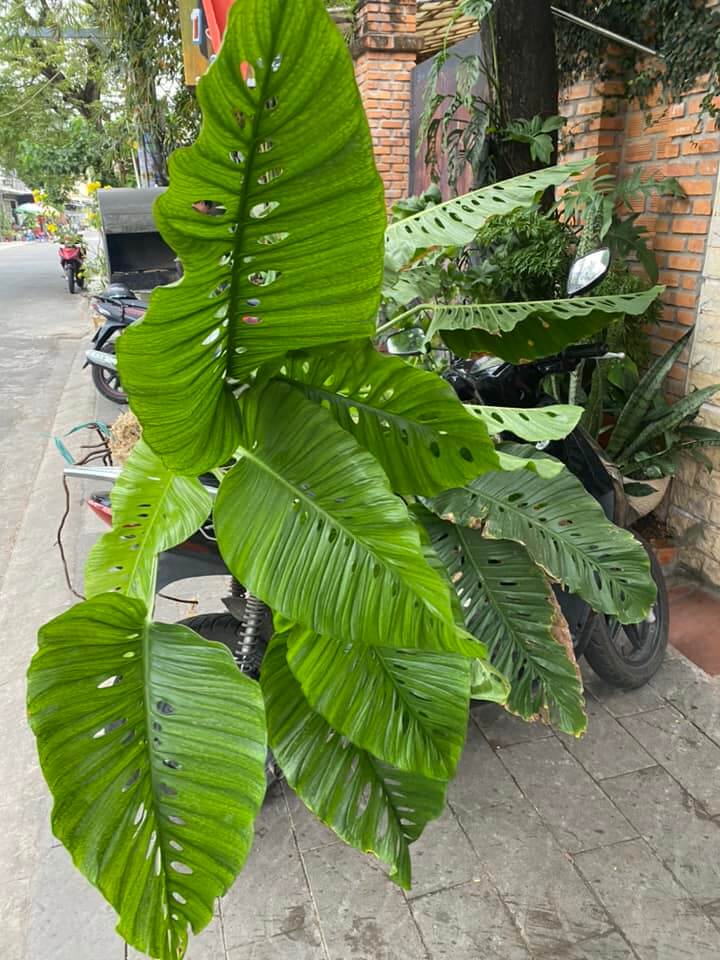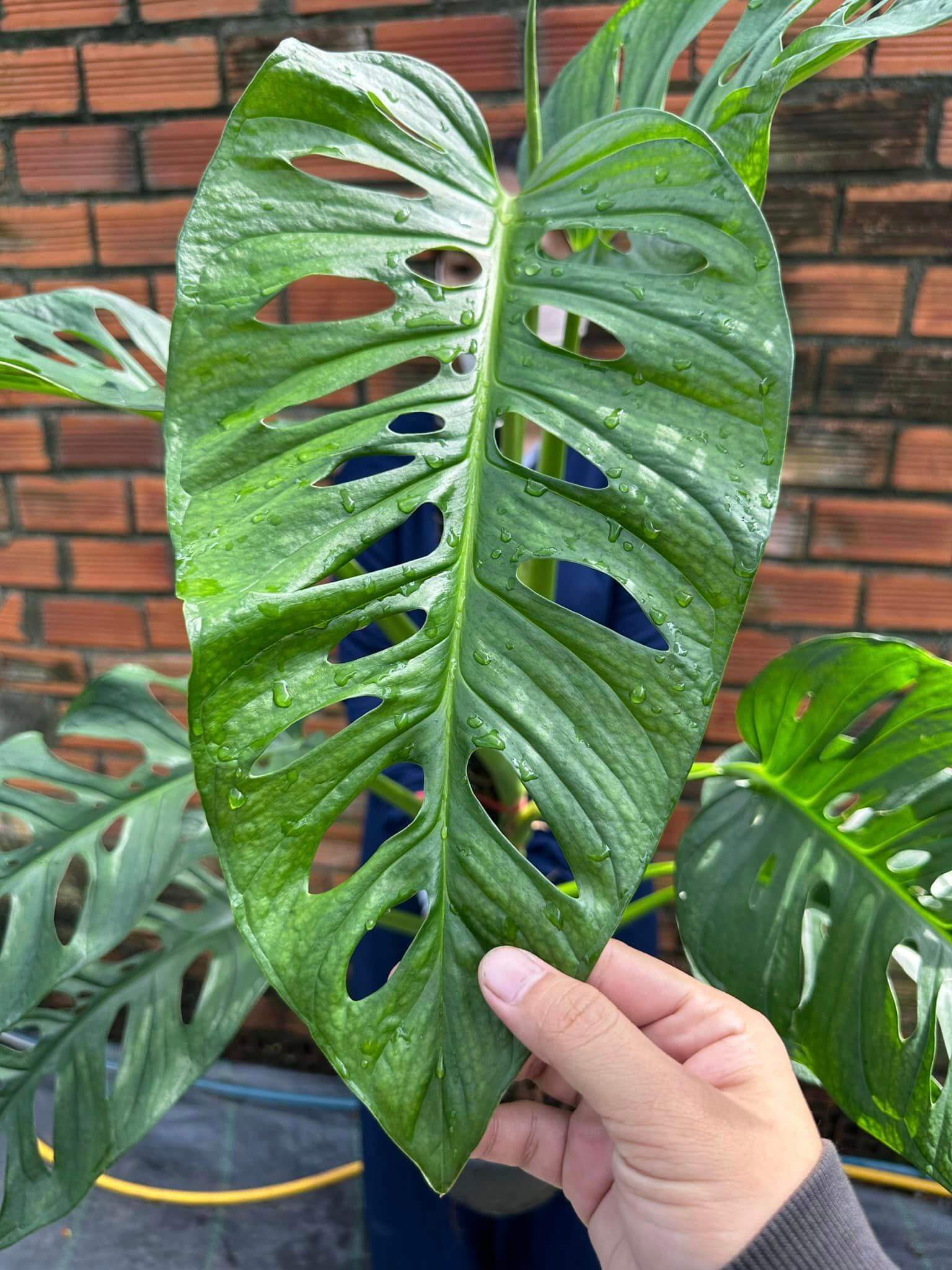Basic Information
Monstera Lechleriana is a stunning and unique variety of monstera that is highly sought after for its beautifully shaped leaves and interesting fenestration pattern. Although this plant may be difficult to locate and distinguish from its close relative, the Monstera Adansonii, it is fairly simple to care for once you have one. Monstera Lechleriana will reward you with its iconic monstera holes and stunning leaves that are sure to impress.



Light
The Monstera plant originates from the damp forests of Mexico, and thus, it thrives in a warm and well-lit environment. It requires bright, indirect light for a minimum of 8 hours per day to thrive. The plant flourishes in bright, dappled indirect sunlight, with approximately 70% to 85% sunlight. For optimum light exposure, placing the plant near east-facing windows is recommended, ensuring that it is not exposed to harsh direct light, which can burn its foliage.
Water
When watering your plants, waiting for the top 3-4 inches of soil to completely dry before watering again is essential. During the spring and summer seasons, it is recommended to water your plants every 7-10 days to ensure healthy growth and well-draining soil. However, the frequency of watering can be reduced in winter. Overwatering can lead to root rot, which is why it is essential to avoid it.
Tip: Ensure your plant’s pot has good drainage to avoid water accumulation and promote healthy root growth
Soil
Monsteras are tropical plants that originate from the wetlands of rainforests. They thrive in soil that is rich in nutrients, organic, and moist while also being well-draining. It is recommended to use a mix that contains peat moss, but avoid soils that are too muddy, dry, or sandy. It is important to ensure that the pot has adequate drainage to prevent waterlogging. Also, be careful to avoid soils that contain bark or compost if you have a Lechleriana, as it will not do well in these types of soil.
Temperature
Monstera Lechleriana thrives in a warm, tropical climate, with an ideal temperature range of 55 – 80 degrees F (13 – 27 degrees C). Be cautious of cold drafts or direct heating sources, and if grown outdoors, bring it inside during colder months.
Humidity
This plant thrives in environments with above-average humidity levels, ideally over 50%. To promote optimal growth, aim for humidity levels above 70%. You can increase humidity by using a humidifier or placing the plant in naturally humid areas such as bathrooms or kitchens. Alternatively, placing a smaller plant on a pebble tray can also help. Just ensure that the leaves, roots, or soil do not come in contact with the water on the tray!
Fertilizer
Did you know that the Monstera Lechleriana requires very little food despite its large size? You only need to feed it a few times a year, making it an easy plant to take care of. We recommend using a high-quality, slow-release fertilizer made explicitly for Monsteras. Feeding the plant three times a year with a balanced, slow-release fertilizer is best. However, if you prefer liquid fertilizer, apply it at half strength every two weeks during the growing season in spring and summer. Be sure to avoid fertilizing your plant in the fall and winter.
Growth Rate
Monstera Lechleriana is a fast-growing plant and may require repotting every 2-3 years. Look for signs like roots peeking out of the drainage hole or stunted growth, indicating that it’s time to repot.
Tip: Monstera is an epiphytic plant that needs support to grow. Wrap coconut fiber around a pipe, stick, or stake and attach it firmly with wire or string. Gently tie your plant onto the support to help it attach.
Pet Safety
The plant contains insoluble oxalate crystals and is toxic if ingested, causing mouth irritation, burns, vomiting, and gastrointestinal discomfort in humans and pets.
Grow in Semi-Hydro
- Monsteras, known for their robust growth and iconic split leaves, flourish in semi-hydroponics systems like LECA/Pon, thanks to their adaptive root systems and love for moisture.
- Transitioning Monstera to semi-hydroponics is effective with a Nutrient Stagnant Wicking (NSW) setup, ensuring a stable and efficient growth environment.
- In LECA/Pon, Monstera roots quickly adjust, overcoming any initial challenges with root adaptation in the NSW system.
- A nutrient mix with a concentration of about 800-1000ppm is ideal for fertilizing Monsteras in semi-hydro setups.
- Monsteras are adaptable to various temperature and humidity conditions, making them suitable for growth in diverse indoor environments.
- Ongoing care includes regular monitoring of the water level in the reservoir and periodic flushing of the system to promote healthy and continuous growth.
Tips
- Position near an east-facing window for ideal light exposure.
- Ensure the soil remains moist but not soggy.
- Aim for high humidity, using humidifiers or natural methods.
- Use a well-draining soil mix to prevent root rot.
- Fertilize during the growing season for optimal growth.
- Repot every 2-3 years to accommodate its fast growth.
- Regularly prune to control size and remove dead foliage.
- Keep out of reach of pets due to its toxicity.
For your Monstera Lechleriana to thrive, provide the right care and attention, and be responsive to its needs. Observation is key to successful houseplant care.
Happy planting! 🌱


